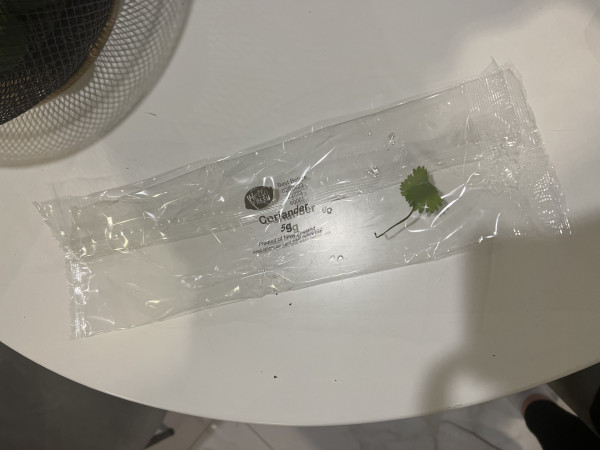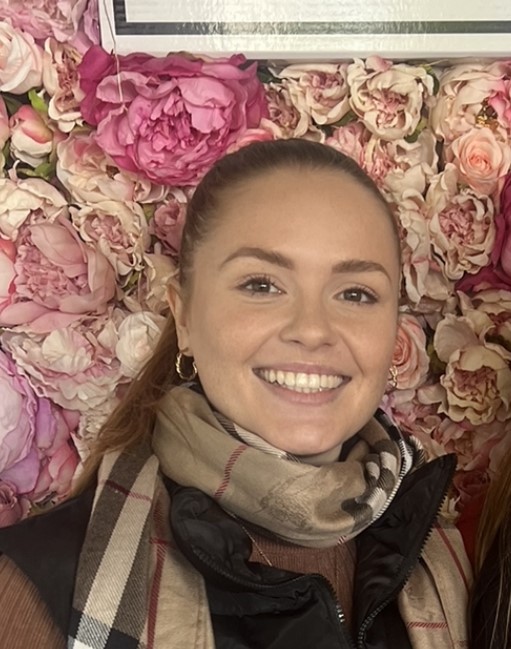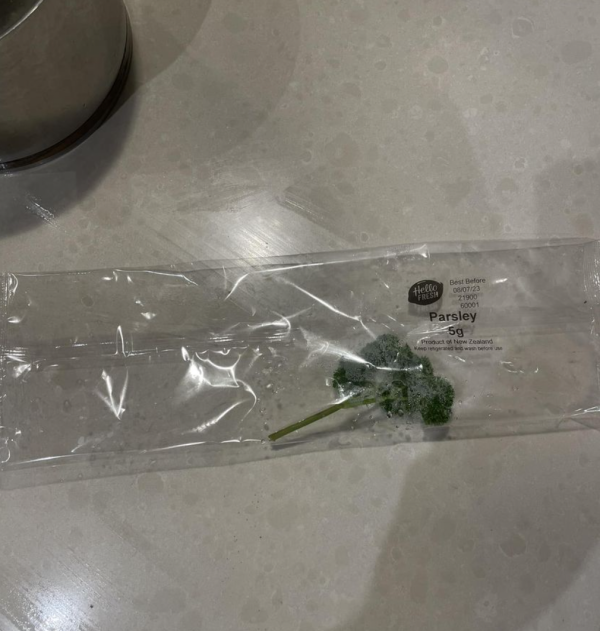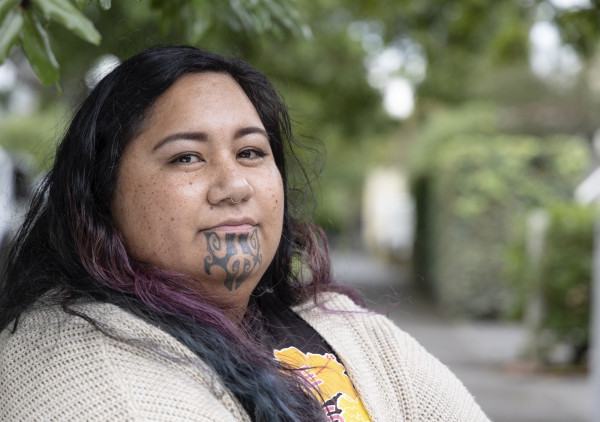When Jaimee Boyce opened her HelloFresh meal kit and saw a lonely coriander leaf encased in a sleeve of plastic like it was a precious artifact, she couldn't help but laugh.
The ‘five grams’ of coriander was meant to be a garnish on top of curry for two people.

Jaimee Boyce says the amount of coriander she received inside plastic packaging was “pathetic”. Photo supplied.
“I just remember thinking, this has to be a mistake? I've had some disappointing moments where they give you two sprigs of herbs in a packet before, but this was just pathetic,” the 30-year-old Aucklander says.
“I even made a joke of cutting the leaf in half and putting one half on top of each serving,” she laughs. “How do they get away with this?”

Jaimee Boyce. Photo: supplied.
Although tiny, the coriander leaf was a leaf too far (or too little) for Jaimee - she cancelled HelloFresh afterwards because she was sick of how much "wasteful" packaging she was receiving.
She has since switched to Wonky Box, a company that delivers surplus or ‘odd’ looking fruits and vegetables without plastic packaging.
“If you were shown beforehand this is what is going to be delivered and asked ‘would you like it or not?’. I think 90% of people would say ‘no, you keep the giant sleeve of plastic, I don’t need one coriander leaf.’”
HelloFresh’s global team told Re: News the lonesome coriander leaf “seems to be an oversight by our supplier and warehouse”.
“Issues like this one happen in isolated incidents and when this occurs, a full refund for this ingredient is given to the customer…Our procurement team has started an investigation and we are also following up with our supplier to understand the error and how it may be remedied.”
But Jaimee is not the only one who has been disappointed by HelloFresh’s packaging.
James Savage recently received a sprig of parsley in the same size sleeve of plastic.

James Savage says the ratio of produce to plastic packaging is “embarrassing”. Photo: Supplied.
“I was laughing when I saw it, I thought it was the most comical thing,” the 20-year-old says.
“It is just such a waste of plastic, I have no idea how it made it so far down their production line without being pulled up on.”
In response to Jame's photo, HelloFresh said: "it’s difficult to determine by picture alone if this is the correct amount of 5g. We did notice the packaging size as an area for improvement and it has been on our sustainable packaging roadmap for some time."
James says he’s heard other people complain about how much plastic HelloFresh uses in their packaging, but “they clearly haven’t resolved it”.
“It's kinda embarrassing on their behalf,” he says.
James was using HelloFresh as a one off but says he definitely wouldn’t buy it again because of the “horrible” waste.
HelloFresh told Re: News alongside CO2 emissions and avoiding food waste, “saving packaging is an essential part” of their sustainability strategy.
“However, we are aware that we still have a lot of work to do when it comes to packaging and our large packaging team is constantly working to further reduce packaging or make it more sustainable.”
“That being said, some packaging is simply necessary to ensure the freshness of the product and prevent food waste."
HelloFresh says its life cycle assessment found packaging material “plays a small role” in emissions emitted compared to other factors such as ingredients or product distribution.
Because of this, HelloFresh says “packaging extends the shelf life of our ingredients and thus prevents food waste...we cannot avoid this specific piece of packaging."
“Ingredient production has by far the biggest environmental footprint which is why any avoidance of waste of ingredients/food benefits our overall sustainability performance.”
Greenpeace Aotearoa plastics campaigner Juressa Lee says any meal kit where every ingredient per dish is individually packaged in plastic, “is a devastating lack of regard for the energy and resources used when that plastic was created”.

Greenpeace Aotearoa plastics campaigner Juressa Lee. Photo: Supplied.
Instead, “a closed loop system whereby meal kit companies collect back ingredient containers to sterilise and use again sounds like an incredible idea to build and support local businesses, promote low waste and low emissions circular economies,” they say.
Recycling soft plastics
HelloFresh’s global team said soft plastics like these can be cleaned and dried and taken to local soft plastic bins for recycling.
However, Lee says recycling attitudes like this is an “industry-created false solution and will not fix the plastics crisis on its own”.
“Only an estimated 9% of all plastic ever made has been recycled.
“However, what HelloFresh is talking about is actually downcycling. You’re not turning say, a herb package back into a herb package, but rather into a fence post for example.
“So one, it doesn’t stop the demand on virgin plastic, and two, whether used as building materials, fence posts, roading or clothing the plastic will break down into micro plastics over time.”
Lee says the cause of plastic pollution is too much plastic and the only viable answer is to stop making it.
A sustainable alternative would be “moving to refill and reuse, making well designed products that last a long time and keeping them in use for as long as possible,” they say.
“Businesses who want to do the right thing need our decision makers’ support with legislation and phase outs that incentivise refill and reuse systems.”